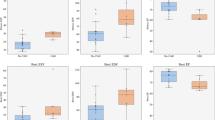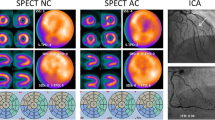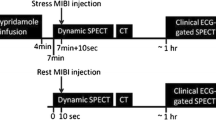Abstract
Background
Because equivocal fixed perfusion defects on single photon emission computed tomography (SPECT) often cause a diagnostic dilemma in patients with suspected coronary artery disease (CAD), we used receiver-operating characteristic (ROC) curve analysis to evaluate the degree of increased accuracy provided by adding gated images for interpretation of such cases.
Methods and results
One hundred five (29%) of 365 consecutive patients undergoing technetium 99m tetrofosmin gated SPECT for evaluation of CAD demonstrated an equivocal fixed defect. Two independent observers graded the probability for true lesion with a 5-point system over 3 steps of interpretation: reviewing tomographic images alone (step 1), adding projection images (step 2), and adding gated cine images (step 3). Based on clinical criteria, 66 patients were categorized as disease negative and 25 as disease positive, while the final diagnosis was undetermined in 14 cases. Diagnostic performance was significantly higher at step 3 than at step 1 for both observers (p<0.05 and <0.0001) and at step 2 for observer B (p<0.005). The maximum accuracy increased from 78.0% to 80.2% at step 2 to 84.6% to 86.8% at step 3. Moreover, the agreement of interpretation between the 2 observers was higher at step 3 (κ=0.53) than at step 1 (ϰ=0.29) or step 2 (ϰ=0.25).
Conclusion
In patients showing an equivocal fixed defect on 99mTc tetrofosmin SPECT, gated cine images provide improved differential accuracy and enhanced objectivity of interpretation by reducing interobserver variance.
Similar content being viewed by others
References
DePasquale EE, Nody AC, Depuey EG, et al. Quantitative rotational thallium-201 tomography for identifying and localizing coronary artery disease. Circulation 1988;77:316–27.
Van Train KF, Maddahi J, Berman DS, et al. Quantitative analysis of tomographic stress thallium-201 myocardial scintigrams: a multicenter trial. J Nucl Med 1990;31:1168–88.
Gordon DG, Pfisterer M, Williams R, et al. The effect of diaphragmatic attenuation on 201Tl images. Clin Nucl Med 1979;4:50.
Goodgold HM, Rehder JG, Samuels LD, Chaitman BR. Improved interpretation of exercise 201Tl myocardial perfusion scintigraphy in women: characterization of breast attenuation artifacts. Radiology 1987;165:361–6.
Eisner RL, Thomas MY, Cloninger K, et al. Normal SPECT thallium-201 bull’s eye display: gender differences. J Nucl Med 1988;29:1901–9.
DePuey EG, Garcia EV. Optimal specificity of thallium-201 SPECT through recognition of imaging artifacts. J Nucl Med 1989;30:441–9.
Manglos SH, Thomas FD, Hellig BJ. Phantom study of breast tissue attenuation in myocardial imaging. J Nucl Med 1993;34:992–6.
Nuyts J, Dupont P, Van den Maegdenbergh V, Vleugels S, Suetens P, Mortelmans L. A study of the liver-heart artifact in emission tomography. J Nucl Med 1995;36:133–9.
DuPuey EG, Rozanski A. Using gated technetium-99m-sestamibi SPECT to characterize fixed myocardial defects as infarct or artifact. J Nucl Med 1995;36:952–5.
Taillefer R, DePuey DG, Udelson JE, Beller GA, Latour Y, Reeves F. Comparative diagnostic accuracy of T1-201 and Tc-99m sestamibi SPECT imaging (perfusion and ECG-gated SPECT) in detecting coronary artery disease in women. J Am Coll Cardiol 1997;29:69–77.
Lee KH, Lee SH, Lee KB, et al. Left ventricular ejection fraction measured by Tc-99m tetrofosmin gated SPECT: Can it replace first pass heart scan acquisitions? [Abstract]. J Nucl Med 1996;37(suppl):179.
Hanley JA, McNeil BJ. The meaning and use of the area under a receiver operating characteristic (ROC) curve. Radiology 1982;143:29–36.
Metz CE. Basic principles of ROC analysis. Semin Nucl Med 1978; 8:283–98.
Manglos SH, Bassano DA, Thomas FD. Cone-beam transmission computed tomography for nonuniform attenuation compensation of SPECT images. J Nucl Med 1991;32:1813–20.
Tsui BM, Gullberg GT, Edgerton ER, et al. Correction of nonuniform attenuation in cardiac SPECT imaging. J Nucl Med 1989;30:497–507.
Frey EC, Tsui BM, Perry JR. Simultaneous acquisition of emission and transmission data for improved thallium-201 cardiac imaging using a technetium 99m transmission source. J Nucl Med 1992;33:2238–45.
Tung CH, Gullberg GT, Zeng GL, Christian PE, Datz FL, Morgan HT. Nonuniform attenuation correction using simultaneous transmission and emission tomography. IEEE Trans Nucl Sci 1992;39:1134–43.
Ficaro EP, Fessler JA, Shreve PD, Kritzman JN, Rose PA, Corbett JR. Simultaneous transmission/emission myocardial perfusion tomography: diagnostic accuracy of attenuation corrected 99mTc-sestamibi single-photon emission computed tomography. Circulation 1996;93:463–73.
Wang SJ, Chen YT, Hwang CL, Lin MS, Kao CH, Yeh SH. 99mTc-sestamibi can improve the inferior attenuation of T1-201 myocardial SPECT imaging. Int J Card Imaging 1993;9:87–92.
DePuey EG. How to detect and avoid myocardial perfusion SPECT artifacts. J Nucl Med 1994;35:699–702.
Garcia EV, Cooke CD, Van Train KF, et al. Technical aspects of myocardial SPECT imaging with technetium-99m sestamibi. Am J Cardiol 1990;66:23E-31E.
Watson DD, Smith WH. Sestamibi and the issue of tissue crosstalk. J Nucl Med 1990;31:1409–11.
Wackers FJT. Diagnostic pitfalls of myocardial perfusion imaging in women. J Myocardial Ischemia 1992;10:23–31.
Takahashi N, Tamaki N, Tadamura E, et al. Combined assessment of regional perfusion and wall motion in patients with coronary artery disease with technetium-99m-tetrofosmin. J Nucl Cardiol 1994;1:29–38.
Gunning MG, Anagnostopoulos C, Davis G, Forbat SM, Ell PJ, Underwood SR. Gated technetium-99m-tetrofosmin SPECT and cine MRI to assess left ventricular contraction. J Nucl Med 1997;38:438–42.
Author information
Authors and Affiliations
Additional information
Supported in part by grant (HMP-96-G-1-02) of the ’96 Highly Advanced National Projects on the development of Biomedical Engineering and Technology, Ministry of Health and Welfare, Republic of Korea.
Rights and permissions
About this article
Cite this article
Choi, J.Y., Lee, K.H., Kim, S.J. et al. Gating provides improved accuracy for differentiating artifacts from true lesions in equivocal fixed defects on technetium 99m tetrofosmin perfusion SPECT. J Nucl Cardiol 5, 395–401 (1998). https://doi.org/10.1016/S1071-3581(98)90145-3
Received:
Accepted:
Issue Date:
DOI: https://doi.org/10.1016/S1071-3581(98)90145-3




